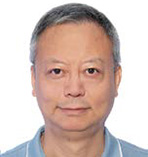
City University of Hong Kong, China
Dr. Hua Zhang obtained his B.S. and M.S. degrees at Nanjing University in China in 1992 and 1995, respectively, and completed his Ph.D. with Prof. Zhongfan Liu at Peking University in China in July 1998. He joined Prof. Frans C. De Schryver’s group at Katholieke Universiteit Leuven (KULeuven) in Belgium as a Research Associate in January 1999. Then he moved to Prof. Chad A. Mirkin’s group at Northwestern University as a Postdoctoral Fellow in July 2001. After worked at NanoInk Inc. (USA) in August 2003, Institute of Bioengineering and Nanotechnology in Singapore in November 2005, he joined Nanyang Technological University (NTU) as an Assistant Professor in July 2006, and was promoted to a tenured Associate Professor on March 1, 2011 and Full Professor on Sept. 1, 2013. In 2019, he joined City University of Hong Kong as a Chair Professor, and currently he is the Herman Hu Chair Professor of Nanomaterials.
He has filed 90+ patent applications (including granted 1 China patent, 1 European patent, 3 Singapore patents, and 10 US patents), and published 500+ papers in Nature (1), Science (1), Nat. Mater. (3), Nat. Chem. (5), Nat. Catal. (2), Nat. Rev. Mater. (2), Nat. Rev. Chem. (1), Nat. Commun. (13), Sci. Adv. (2), Nat. Protocols (1), Chem. Rev. (4), Chem. Soc. Rev. (16), Acc. Chem. Res. (4), Acc. Mater. Res. (1), J. Am. Chem. Soc. (29), Angew. Chem. Int. Ed. (29), Adv. Mater. (74), etc. As at Nov. 2023, the total cited times are over 118,200 with H-index of 172 (Web of Science), and over 138,800 with H-index of 183 (Google Scholar). He has been invited to give more than 300 Plenary, Keynote or Invited Talks in international conferences, universities and institutes. He has organized several tens of international conferences and served as the Conference (Co-)Chair or Symposium Chair.
He is the co-Editor-in-Chief of SmartMat (2020-) and co-Chairman of the Editorial Board of ChemNanoMat (2015-), and sits on the Advisory/Editorial Boards of Chemical Society Reviews (2012-2019), Aggregate (2020-present), Chemical Journal of Chinese Universities (2019-), Energy Materials and Devices (2023-), Materials Chemistry Frontiers (2016-), Matter (2019-), Nanoscale (2012-), Nanoscale Horizons (2015-), NPG Asia Materials (2018-), ACS Nano (2014-), Advanced Functional Materials (2018-), Advanced Materials (2019-), Small (2012-), ACS Appl. Mater. Interfaces (2014-2019), Chem. Mater. (2014-2019), Nanofabrication (2012-2020), 2D Materials (2022-), ACS Omega (2016-), Acta Physico-Chimica Sinica (2020-), Applied Materials Today (2015-), Carbon (2013-), CHEM (2016-), Chemical Reviews (2024-), Chemistry-Methods (2020-), Chinese Science Bulletin (2014-), Electron (2023-), Energy Storage Materials (2015-), EnergyChem (2018-), eScience (2020-), Graphene Technology (2016-), Materials Today Energy (2016-), NANO (2007-2020), Nano Convergence (2020-), npj 2D Materials and Applications (2016-), National Science Review (2023-), Research (2021), The Innovation (2020-), Transactions of Tianjin University (2019), Science China Materials (2014-), Chemistry – An Asian Journal (2018-) and Materials Research Express (2014-2016), ChemPlusChem (2012-2015), and Small Methods (2017-).
In 2020, he was elected as a Foreign Fellow of the European Academy of Sciences (EurASc). In 2015, he was elected as an Academician of the Asia Pacific Academy of Materials (APAM). In Nov. 2014, he was elected as a Fellow of the Royal Society of Chemistry (FRSC). He was listed in the "Highly Cited Researchers" in Materials Science (Clarivate Analytics/Thomson Reuters, 2014-2023 (10 consecutive years)), in Chemistry (Clarivate Analytics/Thomson Reuters, 2015-2023 (9 consecutive years)), and in Environment and Ecology (Clarivate Analytics, 2022). In 2015, he was listed as one of 19 “Hottest Researchers of Today” in the world in the World’s Most Influential Scientific Minds 2015 (Thomson Reuters, 2015). In 2014, he was listed as one of 17 “Hottest Researchers of Today” and No. 1 in Materials and More in the world in the World’s Most Influential Scientific Minds 2014 (Thomson Reuters, 2014). Moreover, he got the IUMRS-Frontier Materials Scientists Award (2023, IUMRS-ICFM), EcoMat Mid-Career Research Award (2023, Wiley-VCH), Outstanding Research Award (2022, City University of Hong Kong), President’s Award (2021, City University of Hong Kong), Young Investigator Award (Young Giants of Nanoscience 2016, Hong Kong), Vice-Chancellor’s International Scholar Award (University of Wollongong, Australia, 2016), ACS Nano Lectureship Award (2015), World Cultural Council (WCC) Special Recognition Award (2013), the ONASSIS Foundation Lectureship (Greece, 2013), Asian Rising Stars (15th Asian Chemical Congress, 2013), SMALL Young Innovator Award (Wiley-VCH, 2012) and Nanyang Award for Research Excellence (2011).
Dr. Zhang’s research is highly interdisciplinary. His current research interests focus on phase engineering of nanomaterials (PEN) and controlled epitaxial growth of heterostructures, including the synthesis of ultrathin two-dimensional nanomaterials (e.g., metal nanosheets, graphene, metal dichalcogenides, metal-organic frameworks, covalent organic frameworks, etc.), novel metallic and semiconducting nanomaterials, novel amorphous nanomaterials, and their hybrid composites for various applications, such as catalysis, clean energy, (opto-)electronic devices, chemical and biosensors, and water remediation.
In this talk, I will summarize the recent research on phase engineering of nanomaterials (PEN) in my group, particularly focusing on the rational design and synthesis of novel 2D nanomaterials with unconventional phases for various promising applications. For example, by using gas-solid reactions, metastable 1T'-phase group VI transition metal dichalcogenides (TMDs), e.g., WS2, WSe2, MoS2, MoSe2, WS2xSe2(1-x) and MoS2xSe2(1-x), have been prepared. Moreover, the salt-assisted 2H-to-1T' phase transformation of TMDs have been achieved, and the phase transformation of TMDs during our developed electrochemical Li-intercalation process has been observed. Impressively, the lithiation-induced amorphization of Pd3P2S8 has been achieved. Currently, my group focuses on the investigation of phase-dependent physicochemical properties and applications in catalysis, (opto-)electronic devices, clean energy, chemical and biosensors, surface enhanced Raman scattering, photothermal therapy, etc., which we believe is quite unique and very important not only in fundamental studies, but also in future practical applications. Importantly, the concept of phase engineering of nanomaterials (PEN) is proposed.